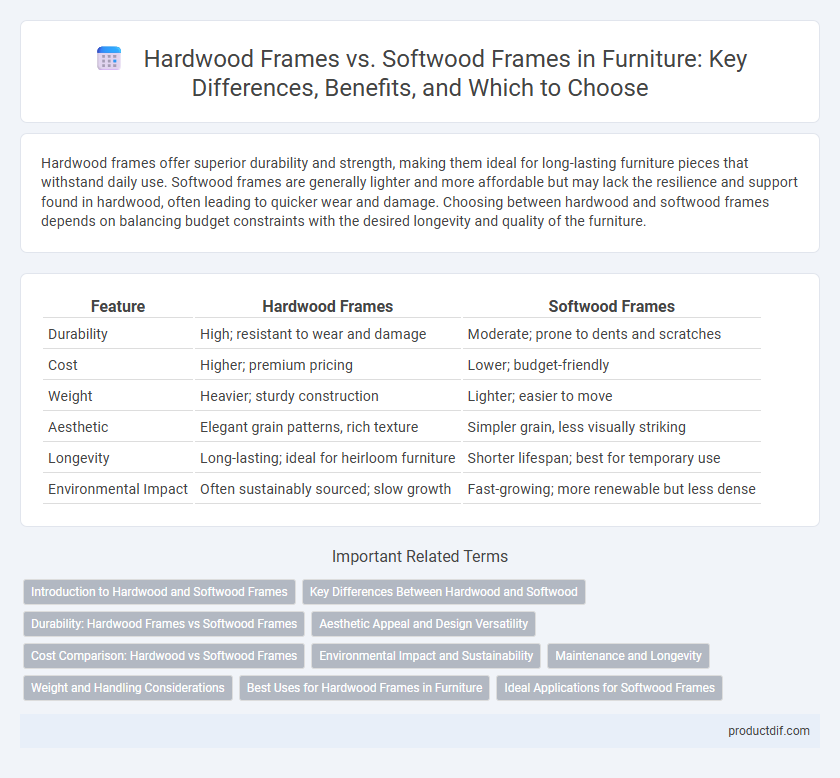Hardwood frames offer superior durability and strength, making them ideal for long-lasting furniture pieces that withstand daily use. Softwood frames are generally lighter and more affordable but may lack the resilience and support found in hardwood, often leading to quicker wear and damage. Choosing between hardwood and softwood frames depends on balancing budget constraints with the desired longevity and quality of the furniture.
Table of Comparison
| Feature | Hardwood Frames | Softwood Frames |
|---|---|---|
| Durability | High; resistant to wear and damage | Moderate; prone to dents and scratches |
| Cost | Higher; premium pricing | Lower; budget-friendly |
| Weight | Heavier; sturdy construction | Lighter; easier to move |
| Aesthetic | Elegant grain patterns, rich texture | Simpler grain, less visually striking |
| Longevity | Long-lasting; ideal for heirloom furniture | Shorter lifespan; best for temporary use |
| Environmental Impact | Often sustainably sourced; slow growth | Fast-growing; more renewable but less dense |
Introduction to Hardwood and Softwood Frames
Hardwood frames, made from dense trees like oak, maple, and walnut, offer superior durability and resistance to wear, making them ideal for long-lasting furniture with a high-end finish. Softwood frames, derived from coniferous trees such as pine, spruce, and fir, provide a lightweight and cost-effective structure, suitable for budget-friendly and easily movable furniture pieces. Both frame types affect the furniture's strength, weight, and overall quality, so choosing between hardwood and softwood depends on intended use and value priorities.
Key Differences Between Hardwood and Softwood
Hardwood frames, derived from deciduous trees like oak, maple, and walnut, offer superior durability, density, and resistance to wear compared to softwood frames made from coniferous trees such as pine, fir, and cedar. Hardwood's tight grain structure enhances structural stability and provides a premium finish, making it ideal for high-quality furniture that lasts longer under heavy use. Softwood frames tend to be lighter and more affordable but are prone to dents and scratches, making them suitable for budget or decorative pieces where strength is less critical.
Durability: Hardwood Frames vs Softwood Frames
Hardwood frames, made from dense species like oak, maple, and walnut, offer superior durability and resistance to wear compared to softwood frames such as pine or cedar. The tighter grain and higher density of hardwoods provide enhanced strength, making them ideal for long-lasting furniture that withstands heavy use. Softwood frames are generally less durable, prone to dents and scratches, and better suited for lightweight or decorative furniture pieces.
Aesthetic Appeal and Design Versatility
Hardwood frames offer superior aesthetic appeal with rich grain patterns and a polished finish that elevate furniture design, making them ideal for classic and high-end interiors. Softwood frames provide greater design versatility due to their lighter weight and ease of manipulation, allowing for intricate shapes and contemporary styles. The choice between hardwood and softwood frames significantly influences the visual impact and adaptability of furniture pieces in diverse decor settings.
Cost Comparison: Hardwood vs Softwood Frames
Hardwood frames generally cost more than softwood frames due to the density and durability of hardwood species like oak, maple, and walnut. Softwood frames, made from pine or fir, are budget-friendly options but may require more frequent replacement or repairs over time. Choosing between hardwood and softwood frames depends on balancing initial investment with long-term value and wear resistance.
Environmental Impact and Sustainability
Hardwood frames, sourced from slow-growing trees such as oak and maple, offer greater durability and longer lifespan, reducing the need for frequent replacements and minimizing environmental waste. Softwood frames, typically from faster-growing species like pine and fir, often require less energy and resources during cultivation but may have shorter durability, potentially leading to increased consumption over time. Sustainable practices in harvesting hardwood involve certified forestry programs like FSC, while softwood frames benefit from rapid renewability, making both options viable depending on responsible sourcing and lifecycle considerations.
Maintenance and Longevity
Hardwood frames, such as oak and maple, offer superior durability and require less frequent maintenance compared to softwood frames like pine, which are more susceptible to dents and scratches. The dense grain structure of hardwood resists warping and pest damage, extending the furniture's lifespan significantly. Regular cleaning and occasional refinishing can preserve the integrity of hardwood frames for decades, while softwood frames may need more frequent repairs and replacements.
Weight and Handling Considerations
Hardwood frames, typically crafted from oak, maple, or mahogany, are denser and heavier, providing superior durability but requiring more effort during handling and transportation. Softwood frames, such as pine or cedar, are lighter and easier to maneuver, making them ideal for furniture that benefits from portability or frequent moving. Weight considerations directly influence furniture assembly, shipping costs, and overall stability, with hardwood offering more robust support at the expense of increased handling difficulty.
Best Uses for Hardwood Frames in Furniture
Hardwood frames are ideal for furniture pieces requiring long-lasting durability and strength, such as dining tables, chairs, and bed frames, due to their dense grain structure and resistance to wear and impact. Common hardwoods like oak, maple, and walnut provide enhanced stability and aesthetic appeal, making them suitable for heirloom-quality and high-traffic furniture. Their natural resistance to dents and scratches also makes hardwood frames preferable for premium upholstery and heavy-use environments.
Ideal Applications for Softwood Frames
Softwood frames are ideal for lightweight furniture pieces such as chairs, tables, and decorative items due to their easier workability and cost-effectiveness. They are well-suited for indoor use where heavy structural support is not critical, making them perfect for rustic or casual furniture designs. Softwood's natural flexibility and affordability make it a practical choice for budget-conscious projects or those requiring frequent modifications.
Hardwood frames vs softwood frames Infographic

 productdif.com
productdif.com